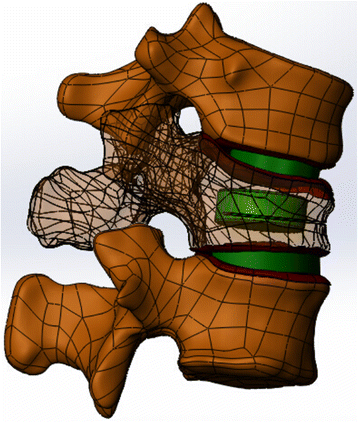Biomechanical effects of different vertebral heights after augmentation of osteoporotic vertebral compression fracture: a three-dimensional finite element analysis
- PMID: 29422073
- PMCID: PMC5806350
- DOI: 10.1186/s13018-018-0733-1
Biomechanical effects of different vertebral heights after augmentation of osteoporotic vertebral compression fracture: a three-dimensional finite element analysis
Abstract
Background: Clinical results have shown that different vertebral heights have been restored post-augmentation of osteoporotic vertebral compression fractures (OVCFs) and the treatment results are consistent. However, no significant results regarding biomechanical effects post-augmentation have been found with different types of vertebral deformity or vertebral heights by biomechanical analysis. Therefore, the present study aimed to investigate the biomechanical effects between different vertebral heights of OVCFs before and after augmentation using three-dimensional finite element analysis.
Methods: Four patients with OVCFs of T12 underwent computed tomography (CT) of the T11-L1 levels. The CT images were reconstructed as simulated three-dimensional finite-element models of the T11-L1 levels (before and after the T12 vertebra was augmented with cement). Four different kinds of vertebral height models included Genant semi-quantitative grades 0, 1, 2, and 3, which simulated unilateral augmentation. These models were assumed to represent vertical compression and flexion, left flexion, and right flexion loads, and the von Mises stresses of the T12 vertebral body were assessed under different vertebral heights before and after bone cement augmentation.
Results: Data showed that the von Mises stresses significantly increased under four loads of OVCFs of the T12 vertebral body before the operation from grade 0 to grade 3 vertebral heights. The maximum stress of grade 3 vertebral height pre-augmentation was produced at approximately 200%, and at more than 200% for grade 0. The von Mises stresses were significantly different between different vertebral heights preoperatively. The von Mises stresses of the T12 vertebral body significantly decreased in four different loads and at different vertebral body heights (grades 0-3) after augmentation. There was no significant difference between the von Mises stresses of grade 0, 1, and 3 vertebral heights postoperatively. The von Mises stress significantly decreased between pre-augmentation and post-augmentation in T12 OVCF models of grade 0-3 vertebral heights.
Conclusion: Vertebral augmentation can sufficiently reduce von Mises stresses at different heights of OVCFs of the vertebral body, although this technique does not completely restore vertebral height to the anatomical criteria.
Keywords: Osteoporotic vertebral compression fracture; Vertebral augmentation; Von Mises stress.
Conflict of interest statement
Ethics approval and consent to participate
This study was granted an exemption from requiring ethics approval by the ethics committee of the Affiliated Hospital of Gansu University of Chinese Medicine. The authors obtained patient consent before enrolling participants in this study.
Consent for publication
Not applicable.
Competing interests
The authors declare that they have no competing interests.
Publisher’s Note
Springer Nature remains neutral with regard to jurisdictional claims in published maps and institutional affiliations.
Figures









Similar articles
-
Finite element analysis of wedge and biconcave deformity in four different height restoration after augmentation of osteoporotic vertebral compression fractures.J Orthop Surg Res. 2021 Feb 15;16(1):138. doi: 10.1186/s13018-021-02225-8. J Orthop Surg Res. 2021. PMID: 33588890 Free PMC article.
-
Biomechanical Effects of Different Spacing Distributions Between the Cemented Superior Boundary and Surgical Vertebral Superior Endplates After Percutaneous Vertebroplasty for Osteoporotic Vertebral Compression Fractures: A Three-Dimensional Finite Element Analysis.Orthop Surg. 2025 Feb;17(2):373-392. doi: 10.1111/os.14292. Epub 2024 Nov 11. Orthop Surg. 2025. PMID: 39529235 Free PMC article.
-
Biomechanical changes of different cement volumes at the thoracolumbar vertebrae in osteoporotic compression fractures: a finite element analysis.BMC Musculoskelet Disord. 2025 Aug 11;26(1):773. doi: 10.1186/s12891-025-09038-4. BMC Musculoskelet Disord. 2025. PMID: 40790748 Free PMC article.
-
Does Percutaneous Vertebroplasty or Balloon Kyphoplasty for Osteoporotic Vertebral Compression Fractures Increase the Incidence of New Vertebral Fractures? A Meta-Analysis.Pain Physician. 2017 Jan-Feb;20(1):E13-E28. Pain Physician. 2017. PMID: 28072794 Review.
-
'Skip' osteoporosis vertebral compression fractures caused by electrical injury: a case report and review of the literature.J Med Case Rep. 2024 Feb 14;18(1):55. doi: 10.1186/s13256-024-04358-w. J Med Case Rep. 2024. PMID: 38351016 Free PMC article. Review.
Cited by
-
Finite element analysis of precise puncture vertebral augmentation in the treatment of different types of osteoporotic vertebral compression fractures.BMC Musculoskelet Disord. 2024 Jul 30;25(1):599. doi: 10.1186/s12891-024-07735-0. BMC Musculoskelet Disord. 2024. PMID: 39080550 Free PMC article.
-
Midterm outcome after posterior stabilization of unstable Midthoracic spine fractures in the elderly.BMC Musculoskelet Disord. 2021 Feb 15;22(1):188. doi: 10.1186/s12891-021-04049-3. BMC Musculoskelet Disord. 2021. PMID: 33588814 Free PMC article.
-
Finite element analysis of wedge and biconcave deformity in four different height restoration after augmentation of osteoporotic vertebral compression fractures.J Orthop Surg Res. 2021 Feb 15;16(1):138. doi: 10.1186/s13018-021-02225-8. J Orthop Surg Res. 2021. PMID: 33588890 Free PMC article.
-
A Multiscale Finite Element Analysis of Balloon Kyphoplasty to Investigate the Risk of Bone-Cement Separation In Vivo.Int J Spine Surg. 2021 Apr;15(2):302-314. doi: 10.14444/8040. Epub 2021 Apr 1. Int J Spine Surg. 2021. PMID: 33900988 Free PMC article.
-
Biomechanical analysis of sandwich vertebrae in osteoporotic patients: finite element analysis.Front Endocrinol (Lausanne). 2023 Oct 11;14:1259095. doi: 10.3389/fendo.2023.1259095. eCollection 2023. Front Endocrinol (Lausanne). 2023. PMID: 37900139 Free PMC article.
References
MeSH terms
Grants and funding
LinkOut - more resources
Full Text Sources
Other Literature Sources
Medical

